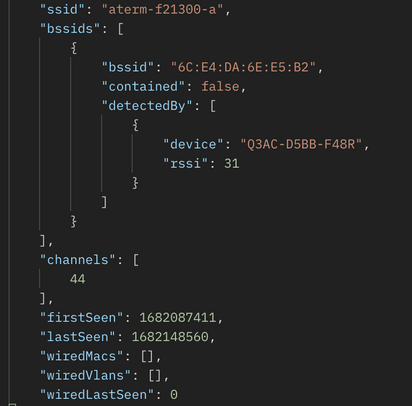Get answers from our community of experts in record time.
Join now- Technical Forums
- :
- Wireless
- :
- Re: Interfering APs bandwidth
Interfering APs bandwidth
- Subscribe to RSS Feed
- Mark Topic as New
- Mark Topic as Read
- Float this Topic for Current User
- Bookmark
- Subscribe
- Mute
- Printer Friendly Page
- Mark as New
- Bookmark
- Subscribe
- Mute
- Subscribe to RSS Feed
- Permalink
- Report Inappropriate Content
Interfering APs bandwidth
Is there any way to get the channel bandwidth of interfering APs using API?
I tried using "airMarshal" API, but it returned only the channel number.
e.g., as in attached image nearby aterm AP operates on 44ch (80MHz), but airMarshal shows only 44.
- Labels:
-
Interference
-
Other
-
RF Spectrum
- Mark as New
- Bookmark
- Subscribe
- Mute
- Subscribe to RSS Feed
- Permalink
- Report Inappropriate Content
If you are talking about the channel width 20 MHz, 40 MHZ or 80 MHz, no it's not possible.
Please, if this post was useful, leave your kudos and mark it as solved.
- Mark as New
- Bookmark
- Subscribe
- Mute
- Subscribe to RSS Feed
- Permalink
- Report Inappropriate Content
Thank you for the reply. Yes, I was trying to get that channel width.
- Mark as New
- Bookmark
- Subscribe
- Mute
- Subscribe to RSS Feed
- Permalink
- Report Inappropriate Content
Channel 44 should be 20mhz , no ?
- Mark as New
- Bookmark
- Subscribe
- Mute
- Subscribe to RSS Feed
- Permalink
- Report Inappropriate Content
Interfering AP "aterm-f21300-a" operates on primary channel 44 and has channel width of 80MHz, which means it occupies the whole 5170-5250MHz. But "airMarshal" shows only 44 and no information about channel width. So I was wondering how to get that info.
- Mark as New
- Bookmark
- Subscribe
- Mute
- Subscribe to RSS Feed
- Permalink
- Report Inappropriate Content
By API it's not possible. But I'm not sure way do you want this information? Technically if auto channel is enable the AP will change for another channel.
Please, if this post was useful, leave your kudos and mark it as solved.
- Mark as New
- Bookmark
- Subscribe
- Mute
- Subscribe to RSS Feed
- Permalink
- Report Inappropriate Content
Then AirMarshal should have labeled it Channel 42. Bit strange
- Mark as New
- Bookmark
- Subscribe
- Mute
- Subscribe to RSS Feed
- Permalink
- Report Inappropriate Content
The 40 MHz channels used by HT and VHT radios are essentially two 20 MHz OFDM channels that are bonded together. Each 40 MHz channel consists of a primary and secondary 20 MHz channel. The primary and secondary 20 MHz channels must be adjacent 20 MHz channels in the frequency in which they operate.
The primary field indicates the number of the primary channel. With 802.11n 40 MHz channels, a positive or negative offset indicates whether the secondary channel is above or below the primary channel. 802.11ac (VHT) does not reference any channel offsets but instead references the center frequency of the 40 MHz channel. However, WLAN vendors do not specify a center frequency when configuring a 40 MHz channel on an 802.11ac access point. Instead, a 20 MHz channel number is selected and that 20 MHz channel functions as the primary channel. Primary and secondary channels are used together only for data frame transmissions between an 802.11n/ac AP and an 802.11n/ac client. For backward compatibility, all 802.11 management and control frames are transmitted only on the primary channel. Additionally, only the primary channel is used for data transmissions between an 802.11n/ac AP and legacy 802.11a/g clients.
- Mark as New
- Bookmark
- Subscribe
- Mute
- Subscribe to RSS Feed
- Permalink
- Report Inappropriate Content
Thanks @AlbertT . Can you link me your reference ? I want to read more about it.
- Mark as New
- Bookmark
- Subscribe
- Mute
- Subscribe to RSS Feed
- Permalink
- Report Inappropriate Content
I have been doing wifi for about 7 years now and am still learning every day.
I can recommend the book Certified Wireless Network
Administrator . (from David D. Coleman,& David A. Westcott )
Also a lot of information can be found at Ekahau website like : (https://www.ekahau.com/resources/?jsf=jet-engine&tax=resource-types:410) and at https://wlanprofessionals.com/ you will find a lot of interesting information this is all without vendor preference and neutral information.
- Mark as New
- Bookmark
- Subscribe
- Mute
- Subscribe to RSS Feed
- Permalink
- Report Inappropriate Content
Thanks all. I anyhow realized that "airMarshal" does not work for this.
Will try to find out if there is any other way to get "channel width" info of neighboring APs.



